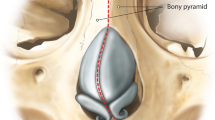Abstract
Background
Crooked nose deformity is one of the most difficult issues to correct by rhinoplasty, as it can result in undesired late sequelae. Revision rates are often high, and numerous operational techniques have been tested. This study describes a crooked nose rhinoplasty technique that reduces the need for a double osteotomy in the long nasal bone.
Methods
This study included 26 patients with an I-shaped crooked nose deformity. In the surgical correction of the crooked nose deformity, previously defined techniques were applied to the cartilage identically. However, the traditional double osteotomy of the long nasal bone was not performed. Instead, the bone protruding laterally from the long nasal bone was narrowed by rasping with a file or burr, and this section was delivered to the maxilla accordingly. Angle values were measured preoperatively and postoperatively. Two lines were used to measure the angle: The first was drawn from the midpoint of the glabella to the midpoint of the upper lip, while the second, representing the nasal dorsal axis, consisted of both the osseous and cartilaginous parts from the nasion to the anterior nasal spine. The angle between these two lines was taken as the angle of deviation from the median line.
Results
Postoperatively, patients’ angle values were significantly smaller than preoperatively. After 1 year, no persistence was observed.
Conclusion
In crooked nose deformity surgery, the osteoplasty technique applied to the lateral protrusion of the long nasal bone described here was as successful as a double osteotomy. Thus, certain complications of a double osteotomy can be avoided. In addition, as no greenstick fractures were induced, the long-term persistence risk was also reduced.
Level of Evidence IV
This journal requires that authors assign a level of evidence to each article. For a full description of these Evidence-Based Medicine ratings, please refer to the Table of Contents or the online Instructions to Authors www.springer.com/00266.










Similar content being viewed by others
References
Stepnick D, Guyuron B (2010) Surgical treatment of the crooked nose. Clin Plast Surg 37:313–325. doi:10.1016/j.cps.2009.12.001
Guyuron B (1998) Nasal osteotomy and airway changes. Plast Reconstr Surg 102:856–860 (discussion 861–3)
Wayne I (2013) Osteotomies in rhinoplasty surgery. Curr Opin Otolaryngol Head Neck Surg 21:379–383. doi:10.1097/MOO.0b013e3283631e85
Okur E, Yildirim I, Aydogan B, Kilic MA (2004) Outcome of surgery for crooked nose: an objective method of evaluation. Aesthet Plast Surg 28:203–207. doi:10.1007/s00266-004-0001-0
Vuyk HD (2000) A review of practical guidelines for correction of the deviated, asymmetric nose. Rhinology 38:72–78
Rohrich RJ, Gunter JP, Deuber MA, Adams WP (2002) The deviated nose: optimizing results using a simplified classification and algorithmic approach. Plast Reconstr Surg 110:1509–1523. doi:10.1097/01.PRS.0000072285.47341.C4 (discussion 1524–1525)
Toriumi DM (2013) Subtotal septal reconstruction: an update. Fac Plast Surg 29:492–501. doi:10.1055/s-0033-1360600
Boccieri A, Pascali M (2003) Septal crossbar graft for the correction of the crooked nose. Plast Reconstr Surg 111:629–638. doi:10.1097/01.PRS.0000042205.27330.E4
Akbaş H, Keskin M, Güneren E et al (2002) Unilateral osteotomies for externally deviated noses. Aesthet Plast Surg 26:413–415. doi:10.1007/s00266-002-2050-6
Rettinger G (2007) Risks and complications in rhinoplasty. GMS Curr Top Otorhinolaryngol Head Neck Surg 8:Doc08. doi:10.1055/s-2007-966304
McKinney P, Shively R (1979) Straightening the twisted nose. Plast Reconstr Surg 64:176–179
Vuyk HD, Adamson PA (1998) Biomaterials in rhinoplasty. Clin Otolaryngol Allied Sci 23:209–217
Author information
Authors and Affiliations
Corresponding author
Ethics declarations
Conflict of interest
The authors declare that they have no conflicts of interest to disclose.
Ethical Approval
All procedures performed in studies involving human participants were in accordance with the ethical standards of the institutional and/or national research committee and with the 1964 Helsinki Declaration and its later amendments or comparable ethical standards.
Rights and permissions
About this article
Cite this article
Koçak, I., Senturk, E. Osteoplasty in Crooked Nose Deformity: A Novel Approach. Aesth Plast Surg 41, 628–636 (2017). https://doi.org/10.1007/s00266-017-0848-5
Received:
Accepted:
Published:
Issue Date:
DOI: https://doi.org/10.1007/s00266-017-0848-5




